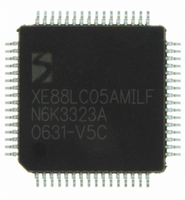XE8805AMI028LF Semtech, XE8805AMI028LF Datasheet - Page 108

XE8805AMI028LF
Manufacturer Part Number
XE8805AMI028LF
Description
IC DAS 16BIT FLASH 8K MTP 64LQFP
Manufacturer
Semtech
Datasheet
1.XE8805AMI028LF.pdf
(156 pages)
Specifications of XE8805AMI028LF
Applications
Sensing Machine
Core Processor
RISC
Program Memory Type
FLASH (22 kB)
Controller Series
XE8000
Ram Size
512 x 8
Interface
UART, USRT
Number Of I /o
24
Voltage - Supply
2.4 V ~ 5.5 V
Operating Temperature
-40°C ~ 85°C
Mounting Type
Surface Mount
Package / Case
64-LQFP
Supply Voltage Range
2.4V To 5.5V
Operating Temperature Range
-40°C To +85°C
Digital Ic Case Style
LQFP
No. Of Pins
64
For Use With
XE8000MP - PROG BOARD AND PROSTART2 CARD
Lead Free Status / RoHS Status
Lead free / RoHS Compliant
Available stocks
Company
Part Number
Manufacturer
Quantity
Price
Part Number:
XE8805AMI028LF
Manufacturer:
SEMTECH/美国升特
Quantity:
20 000
XE8805/05A
Figure 16-8. Integral non-linearity of the ADC (PGA disabled, reference voltage of 4.8V)
The different PGA stages have been designed to find the best compromise between the noise performance, the
integral non-linearity and the power consumption. To obtain this, the first stage has the best noise performance and
the third stage the best linearity performance. For large input signals (small PGA gains, i.e. up to about 50), the
noise added by the PGA is very small with respect to the input signal and the second and third stage of the PGA
should be used to get the best linearity. For small input signals (large gains, i.e. above 50), the noise level in the
PGA is important and the first stage of the PGA should be used.
The following figures give the non-linearity for different gain settings of the PGA, selecting the appropriate stage to
get the best noise and linearity performance. Figure 16-9 shows the non-linearity when the third stage is used with
a gain of 1. It is of course not very useful to use the PGA with a gain of 1 unless it is used to compensate offset. By
increasing the gain, the integral non-linearity becomes even smaller since the signal in the amplifiers reduces.
Figure 16-10 shows the non-linearity for a gain of 2. Figure 16-11 shows the non-linearity for a gain of 5. Figure
16-12 shows the non-linearity for a gain of 10. By comparing these figures to Figure 16-8, it can be seen that the
third stage of the PGA does not add significant integral non-linearity.
Figure 16-13 shows the non-linearity for a gain of 20 and Figure 16-14 shows the non-linearity for a gain of 50. In
both cases the PGA2 is used at a gain of 10 and the remaining gain is realized by the third stage. It can be seen
again that the second stage of the PGA does not add significant non-linearity.
For gains above 50, the first stage PGA1 should be selected in stead of PGA2. Although the non-linearity in the first
stage of the PGA is larger than in stage 2 and 3, the gain in stage 3 is now sufficiently high so that the non-linearity
of the first stage does become negligible as is shown in Figure 16-15 for a gain of 100. Therefor, the first stage is
preferred over the second stage since it has less noise.
Increasing the gain further up to 1000 will further increase the linearity since the signal becomes very small in the
first two stages. The signal is full scale at the output of stage 3 and as shown in Figure 16-9 to Figure 16-12, this
stage has very good linearity.
© Semtech 2006
www.semtech.com
16-22














